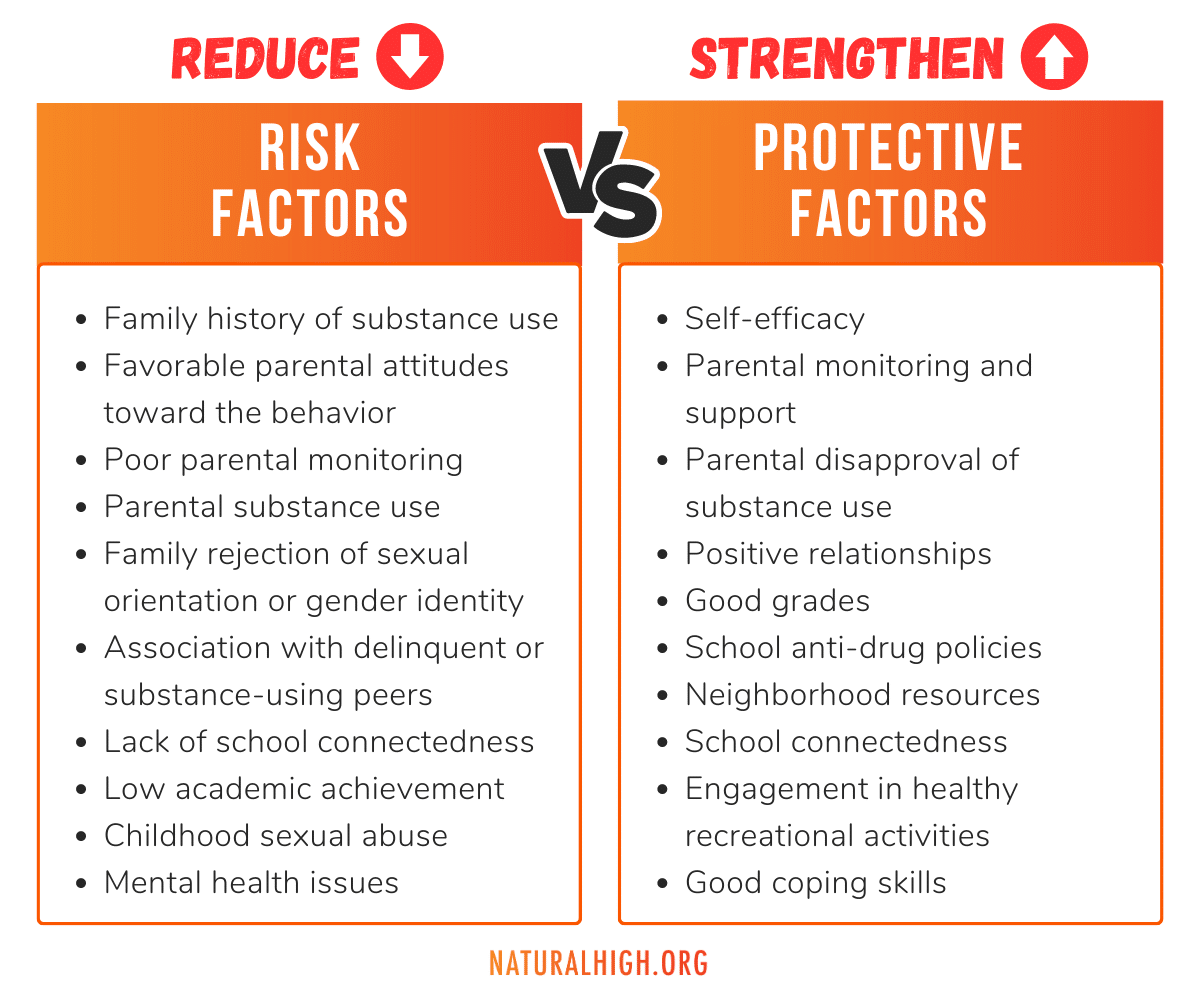Why do some people become addicted to drugs, while others do not? The National Institute on Drug Abuse explains it like this: “As with other diseases and disorders, the likelihood of developing an addiction differs from person to person, and no single factor determines whether a person will become addicted to drugs.”
In general, the more risk factors a person has, the greater the chance that taking drugs will lead to drug use and addiction.
Protective factors, on the other hand, reduce a person’s risk.
Risk and protective factors may be either environmental or biological.
Let’s first start by defining “risk factors”. Risk factors are the environmental, biological, or psychological influences that can make it much more likely for a kid to consume harmful substances than a kid who isn’t exposed to the same influences.
It’s important to understand that all kids are exposed to different risk factors regarding substance use, but not all risk factors are alike.
And some risk factors are more malleable than others. The Centers for Disease Control and Prevention (CDC) detail several of the most prominent risk factors children face:
- Family history of substance use
- Favorable parental attitudes toward the behavior
- Poor parental monitoring
- Parental substance use
- Family rejection of sexual orientation or gender identity
- Association with delinquent or substance-using peers
- Lack of school connectedness
- Low academic achievement
- Childhood sexual abuse
- Mental health issues
Reviewing their list, some are clearly more fixed than others. In other words, we can’t prevent or protect them necessarily, we can only try to mitigate their risk and exposure.
The optimistic headline is that all Risk Factors can be counterbalanced by what’s known as Protective Factors — essentially, a kid’s exposure to experiences and skills that would give them what they need to avoid substance use and abuse.
The goal is to reduce risk factors and strengthen protective factors.

We can be deliberate in cultivating an environment for kids at home and at school that gives them a better chance at avoiding substances that can ruin their lives.
The National Institute on Drug Abuse (NIDA) shares a brief list of the most effective protective factors to put in place for a kid.
Why is early substance use prevention so important?
Research shows that the majority of those who have a substance use disorder in their lifetime started using substances during adolescence.
Alcohol and other substances have particularly potent effects on developing brain circuits, and brain development is not complete until around age 23. Among the last brain regions to reach maturity is the prefrontal cortex, the brain region primarily responsible for “adult” abilities, such as delay of reward, extended reasoning, and impulse control.
The prefrontal cortex is one of the most affected regions in a substance use disorder.
For over twenty-five years, we’ve been studying the research on the most effective protective factors for kids and translating them into adaptable and relevant (and totally free) curriculum for families and schools.
A few to highlight:
- Help kids find their spark: Research has shown one of the single most effective protective factors for helping youth thrive and lowering addiction risk is to inspire them to identify and pursue their Natural High. Inspire them to find their passion, get involved, and show them it’s a better choice.
- Introduce kids to healthy role models: Peer influence and the power of social and cultural influencers dramatically influences youth behavior. At Natural High, we speak to youth through powerful storytellers to whom they can relate. We empower youth through social norming to understand that many cultural icons and their peers choose their Natural High over drug and alcohol abuse.
- Facilitate mentorship: Natural High taps into the power of mentors to reach youth and helps to accelerate and strengthen the mentor/youth relationship. We know that youth with caring, supportive relationships with adults and mentors are more likely to develop perseverance and motivation.
- Cultivate self-confidence: Our storytellers convey that abilities and talents can be developed through effort and persistence, and they motivate youth to learn and improve their skills. Youth who believe they can achieve their goals through hard work are inspired to work harder. Natural High’s videos and supporting curriculum help teachers move youth toward a positive mindset.
- Relevant goal-setting: Youth who set goals learn to avoid taking poorly thought-out short-term actions and develop a more positive and motivated outlook. Natural High arms teachers with science-based content to support the teaching of goal-setting strategies.
We aren’t powerless when it comes to supporting kids in the pursuit of healthy lifestyles. We can give kids the best chance to lead healthy lives with intentional and consistent effort.


